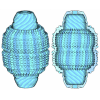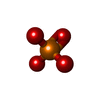+ Open data
Open data
- Basic information
Basic information
| Entry | Database: PDB / ID: 3mpw | ||||||
|---|---|---|---|---|---|---|---|
| Title | Structure of EUTM in 2-D protein membrane | ||||||
 Components Components | Ethanolamine utilization protein eutM | ||||||
 Keywords Keywords | MEMBRANE PROTEIN / Bacterial microcompartment / shell protein / ethanolamine ammonia lyase / carboxysome | ||||||
| Function / homology |  Function and homology information Function and homology informationethanolamine degradation polyhedral organelle / ethanolamine catabolic process / protein hexamerization / structural molecule activity / identical protein binding Similarity search - Function | ||||||
| Biological species |  | ||||||
| Method |  X-RAY DIFFRACTION / X-RAY DIFFRACTION /  SYNCHROTRON / SYNCHROTRON /  MOLECULAR REPLACEMENT / Resolution: 2.7 Å MOLECULAR REPLACEMENT / Resolution: 2.7 Å | ||||||
 Authors Authors | Sagermann, M. / Takenoya, M. / Nikolakakis, K. | ||||||
 Citation Citation |  Journal: J.Bacteriol. / Year: 2010 Journal: J.Bacteriol. / Year: 2010Title: Crystallographic insights into the pore structures and mechanisms of the EutL and EutM shell proteins of the ethanolamine-utilizing microcompartment of Escherichia coli. Authors: Takenoya, M. / Nikolakakis, K. / Sagermann, M. #1:  Journal: Proc.Natl.Acad.Sci.USA / Year: 2009 Journal: Proc.Natl.Acad.Sci.USA / Year: 2009Title: Crystal structure of the EutL shell protein of the ethanolamine ammonia lyase microcompartment. Authors: Sagermann, M. / Ohtaki, A. / Nikolakakis, K. | ||||||
| History |
|
- Structure visualization
Structure visualization
| Structure viewer | Molecule:  Molmil Molmil Jmol/JSmol Jmol/JSmol |
|---|
- Downloads & links
Downloads & links
- Download
Download
| PDBx/mmCIF format |  3mpw.cif.gz 3mpw.cif.gz | 198.7 KB | Display |  PDBx/mmCIF format PDBx/mmCIF format |
|---|---|---|---|---|
| PDB format |  pdb3mpw.ent.gz pdb3mpw.ent.gz | 161.5 KB | Display |  PDB format PDB format |
| PDBx/mmJSON format |  3mpw.json.gz 3mpw.json.gz | Tree view |  PDBx/mmJSON format PDBx/mmJSON format | |
| Others |  Other downloads Other downloads |
-Validation report
| Summary document |  3mpw_validation.pdf.gz 3mpw_validation.pdf.gz | 528.8 KB | Display |  wwPDB validaton report wwPDB validaton report |
|---|---|---|---|---|
| Full document |  3mpw_full_validation.pdf.gz 3mpw_full_validation.pdf.gz | 637.6 KB | Display | |
| Data in XML |  3mpw_validation.xml.gz 3mpw_validation.xml.gz | 54.3 KB | Display | |
| Data in CIF |  3mpw_validation.cif.gz 3mpw_validation.cif.gz | 71.5 KB | Display | |
| Arichive directory |  https://data.pdbj.org/pub/pdb/validation_reports/mp/3mpw https://data.pdbj.org/pub/pdb/validation_reports/mp/3mpw ftp://data.pdbj.org/pub/pdb/validation_reports/mp/3mpw ftp://data.pdbj.org/pub/pdb/validation_reports/mp/3mpw | HTTPS FTP |
-Related structure data
| Related structure data | 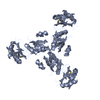 3mpvC  3mpyC  2a1bS S: Starting model for refinement C: citing same article ( |
|---|---|
| Similar structure data |
- Links
Links
- Assembly
Assembly
| Deposited unit | 
| ||||||||
|---|---|---|---|---|---|---|---|---|---|
| 1 | 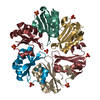
| ||||||||
| 2 | 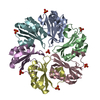
| ||||||||
| Unit cell |
|
- Components
Components
| #1: Protein | Mass: 10706.420 Da / Num. of mol.: 12 Source method: isolated from a genetically manipulated source Source: (gene. exp.)   #2: Chemical | ChemComp-PO4 / |
|---|
-Experimental details
-Experiment
| Experiment | Method:  X-RAY DIFFRACTION / Number of used crystals: 1 X-RAY DIFFRACTION / Number of used crystals: 1 |
|---|
- Sample preparation
Sample preparation
| Crystal | Density Matthews: 2.46 Å3/Da / Density % sol: 50.01 % |
|---|---|
| Crystal grow | Temperature: 298 K / Method: vapor diffusion, hanging drop / pH: 6.5 Details: 100 MM SODIUM DIHYDROGEN PHOSPHATE, 100 MM POTASSIUMDIHYDROGENPHOSPHATE, 2 M SODIUM CHLORIDE, pH 6.5, VAPOR DIFFUSION, HANGING DROP, temperature 298K |
-Data collection
| Diffraction | Mean temperature: 100 K |
|---|---|
| Diffraction source | Source:  SYNCHROTRON / Site: SYNCHROTRON / Site:  SSRL SSRL  / Beamline: BL7-1 / Wavelength: 0.97946 Å / Beamline: BL7-1 / Wavelength: 0.97946 Å |
| Detector | Type: ADSC QUANTUM 315r / Detector: CCD / Date: Jun 11, 2009 / Details: Rh coated flat mirror |
| Radiation | Monochromator: SI 111 MIRROR / Protocol: SINGLE WAVELENGTH / Monochromatic (M) / Laue (L): M / Scattering type: x-ray |
| Radiation wavelength | Wavelength: 0.97946 Å / Relative weight: 1 |
| Reflection | Resolution: 2.7→46.98 Å / Num. obs: 25180 / % possible obs: 84.1 % / Observed criterion σ(F): 0 / Observed criterion σ(I): 0 / Redundancy: 2.1 % / Rmerge(I) obs: 0.032 / Net I/σ(I): 19.31 |
- Processing
Processing
| Software | Name: REFMAC / Version: 5.5.0066 / Classification: refinement | ||||||||||||||||||||||||||||||||||||||||||||||||||||||||||||||||||||||||||||||||||||||||||||||||||||||||||||||||||||||||||||||||||||||||||||||||||||||||||||||||||||||||||
|---|---|---|---|---|---|---|---|---|---|---|---|---|---|---|---|---|---|---|---|---|---|---|---|---|---|---|---|---|---|---|---|---|---|---|---|---|---|---|---|---|---|---|---|---|---|---|---|---|---|---|---|---|---|---|---|---|---|---|---|---|---|---|---|---|---|---|---|---|---|---|---|---|---|---|---|---|---|---|---|---|---|---|---|---|---|---|---|---|---|---|---|---|---|---|---|---|---|---|---|---|---|---|---|---|---|---|---|---|---|---|---|---|---|---|---|---|---|---|---|---|---|---|---|---|---|---|---|---|---|---|---|---|---|---|---|---|---|---|---|---|---|---|---|---|---|---|---|---|---|---|---|---|---|---|---|---|---|---|---|---|---|---|---|---|---|---|---|---|---|---|---|
| Refinement | Method to determine structure:  MOLECULAR REPLACEMENT MOLECULAR REPLACEMENTStarting model: PDB entry 2A1B (residues 2-90) Resolution: 2.7→46.98 Å / Cor.coef. Fo:Fc: 0.914 / Cor.coef. Fo:Fc free: 0.838 / SU B: 20.657 / SU ML: 0.423 / Cross valid method: THROUGHOUT / σ(F): 0 / σ(I): 0 / ESU R Free: 0.518 / Stereochemistry target values: MAXIMUM LIKELIHOOD / Details: HYDROGENS HAVE BEEN ADDED IN THE RIDING POSITIONS
| ||||||||||||||||||||||||||||||||||||||||||||||||||||||||||||||||||||||||||||||||||||||||||||||||||||||||||||||||||||||||||||||||||||||||||||||||||||||||||||||||||||||||||
| Solvent computation | Ion probe radii: 0.8 Å / Shrinkage radii: 0.8 Å / VDW probe radii: 1.4 Å / Solvent model: BABINET MODEL WITH MASK | ||||||||||||||||||||||||||||||||||||||||||||||||||||||||||||||||||||||||||||||||||||||||||||||||||||||||||||||||||||||||||||||||||||||||||||||||||||||||||||||||||||||||||
| Displacement parameters | Biso mean: 33.121 Å2
| ||||||||||||||||||||||||||||||||||||||||||||||||||||||||||||||||||||||||||||||||||||||||||||||||||||||||||||||||||||||||||||||||||||||||||||||||||||||||||||||||||||||||||
| Refinement step | Cycle: LAST / Resolution: 2.7→46.98 Å
| ||||||||||||||||||||||||||||||||||||||||||||||||||||||||||||||||||||||||||||||||||||||||||||||||||||||||||||||||||||||||||||||||||||||||||||||||||||||||||||||||||||||||||
| Refine LS restraints |
| ||||||||||||||||||||||||||||||||||||||||||||||||||||||||||||||||||||||||||||||||||||||||||||||||||||||||||||||||||||||||||||||||||||||||||||||||||||||||||||||||||||||||||
| LS refinement shell | Resolution: 2.7→2.77 Å / Total num. of bins used: 20
|
 Movie
Movie Controller
Controller





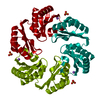




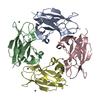



 PDBj
PDBj